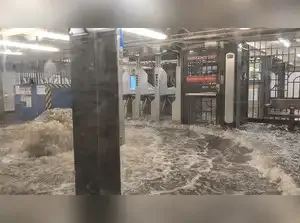A sudden deluge of rain brought chaos to New York City’s transit system on Thursday(July 31), turning subway stations into rivers and prompting terrifying scenes underground as commuters climbed walls and gates to avoid rising waters.
A powerful storm system swept across the Northeast, delivering several inches of rain in just a few hours. New York Governor Kathy Hochul and Mayor Eric Adams declared a state of emergency as transportation systems buckled, highways became impassable, and emergency services were overwhelmed.
But it was underground where the most surreal images emerged.
Subway system overwhelmed
Videos from multiple stations showed water gushing into platforms and stairwells. At the 7th Avenue station in Brooklyn, passengers were seen scaling the station’s walls and gripping metal fences, desperate to avoid the floodwater that quickly covered the floor. Many stood perched on benches or holding onto poles, waiting for help or for the water to recede.
At Grand Central Terminal, one of the city's busiest transit hubs, waterfalls cascaded from the ceiling onto Metro-North platforms. Footage shared widely on social media showed passengers fleeing down slick walkways as torrents of water fell from light fixtures and ventilation shafts. One video showed water pouring down directly onto a parked train, soaking passengers attempting to board.
Widespread flooding and travel disruptions
By the evening, flash flood warnings were issued across all five boroughs. Bayside, Queens recorded more than 6 inches of rain, with other neighborhoods averaging between 2–4 inches.
Major roadways like the Clearview Expressway were submerged, with multiple vehicles stranded, including an 18-wheeler caught mid-highway. Drivers abandoned their cars, while some required water rescues from first responders.
At Bayside LIRR Station, emergency crews used ladders to help evacuate passengers trapped on a train immobilized by rising water. Inbound and outbound rail service was severely impacted, and delays rippled through both MTA subway and commuter rail systems well into Friday morning.
The storm also caused over 1,100 flight cancellations across JFK, LaGuardia, and Newark airports, as ground operations were briefly halted due to lightning and waterlogged tarmacs.
Aging infrastructure under scrutiny
The incident raised concerns about New York’s aging infrastructure and its vulnerability to climate-driven extreme weather events. Transit officials admitted the subway’s drainage system was overwhelmed by the sheer intensity of the storm, which dropped more water in a few hours than some parts of the city typically receive in a month.
Critics argue that planned climate resiliency upgrades have been delayed or underfunded. A 2021 federal grant earmarked for flood mitigation remains partially unspent, and efforts to fortify key stations are still in design phases.
Emergency measures and recovery
City officials urged residents, especially those living in basement apartments, to stay alert and avoid flooded areas. Shelters were opened in flood-prone communities, and the Office of Emergency Management deployed teams to inspect subway tunnels and underpasses.
As of Friday morning, most subway lines had resumed partial service, though delays persisted across multiple routes. Clean-up crews worked overnight to clear debris, pump water from tunnels, and assess damage to signaling systems.
